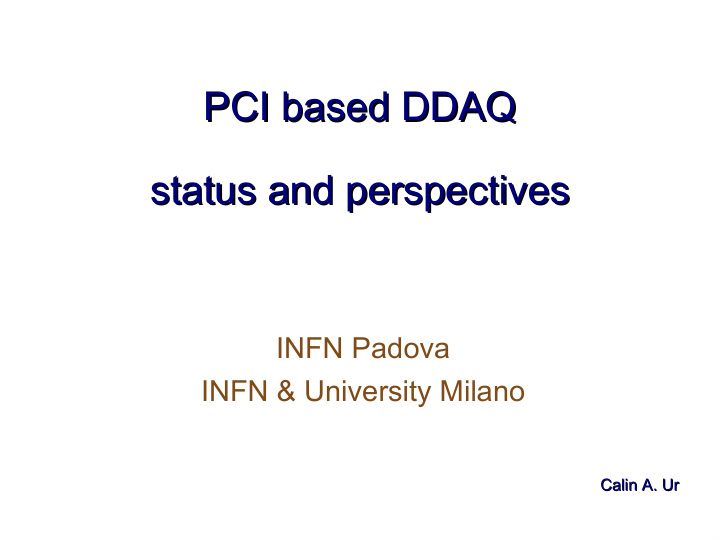



PCI based DDAQ PCI based DDAQ status and perspectives status and perspectives INFN Padova INFN & University Milano Calin A. Ur Calin A. Ur
Installed at LNGS Installed at LNGS ALTERA APEX 20K200EFC484
Main features Main features MD2S Padova Channels 4/module Channels FADC bits 14 FADC rate (MHz) 100 FPGA k-gates/ch 100 40 µ s for energy Internal trigger no 5 µ s for PSA Trace length (samples) 1024 @ 25 MHz 512 @ 100 MHz Control & i/f NIM/PCI Obsolete Data xfr PCI Core PCI 32bit/33MHz Interrupt Max output rate (MB/s) 6 based RO
Data transfer improved Data transfer improved Upgraded to the latest ALTERA core PCI Upgraded to the latest ALTERA core PCI - implemented DMA RO → success - updated the core PCI → PCI transfer at 32bit/66MHz → max.output rate > 60 MB/s (calibrations) – limited by the HD write speed - added: 64 bit clock counter @ 100 MHz / NIM module 32 bit trigger counter system running test measurements - forced synchronization of data transfer from several boards → 1 master PCI board – produces the irq request → slave PCI boards – notify the master board when transfer is finished
Internal trigger Internal trigger - implemented in the Xilinx FPGA's on the NIM boards - simple algorithm – dual delay line – triangular filter – signal offset removal – independent of the signal height – low energy threshold - threshold programmed from PC via parallel port - individual output trigger signals TTL - eliminates the need of splitting the signals from the Ge detectors - simplifies the trigger electronics needed for starting the DAQ
Some sample images Some sample images
New DAQ layout New DAQ layout Thr. PC TTL
Remote control Remote control Visible to the LNGS network Outside world tunnel via a local PC
Data format Data format *************** HEADER (ASCII) *************** ?PCIDAQ0 data label ?CHN0003 number of enabled channels ?WVN0002 number of waves for each channel (1 or 2) ?P101024 number of bins in the first wave (fixed) ?P200256 number of bins in the second wave ?D103000 how many 10 ns after trigger in the first wave ?D200450 how many 10 ns after trigger in the second wave ?SPR0016 output sample precision in bits ?BIT0014 number of FADC conversion bits ?FRQ0100 sampling frequency in MHz ?LTR0020 event trailer length in bytes ?CH10002 channel #1 Enable Pattern 0000000010 .........(channel #1 of card #2 is enabled; card #1 is LSB) ?CH20000 channel #2 Enable Pattern 0000000000 .........(no channels #2 enabled) ?CH30001 channel #3 Enable Pattern 0000000001 .........(channel #3 of card #1 is enabled) ?CH40002 channel #4 Enable Pattern 0000000010 .........(channel #4 of card #2 is enabled ?JHZ0100 frequency of jiffies (100 Hz) depends on the OS ?RUN0007 run number ?ORIGDAT original data ?U000029 user comment length (in bytes) "Data Conmment with User Comment Text" "new lines" ".............." up to 512 characters ?ENDHEAD end of header
Data format Data format *************** Data *************** 1st Event: Number_of_Channels_Enabled * ........................ 3 Number_of_Points_wave_1 * sizeof(u16) + ...... 1024 * 2 Number_of_Points_wave_2 * sizeof(u16) + ....... 256 * 2 Event_Trailer_Lentgh = ............................. 20 Event_Length = .................................... 7700 bytes Event Trailer Format - 5 x u32 integers = 20 bytes #0 = Trigger counter (Event ID) #1 = Time stamp high #2 = Time stamp low #3 = data acqusition time measured in jiffies (10 ms) #4 = End Of Event = 0xFFFFFFFF 2nd Event: ....
Future work Future work - modify all the boards for the trigger signals extraction - electronics workshop – INFN Padova - thorough tests of the newly implemented features - define the event format - integration: – muon – veto system – nat Ge veto
Collaborators Collaborators C. Rossi Alvarez – INFN Padova S. Riboldi – INFN & University of Milano R. Isocrate – INFN Padova C. Manea – INFN Padova Electronics workshop – INFN Padova
Recommend
More recommend